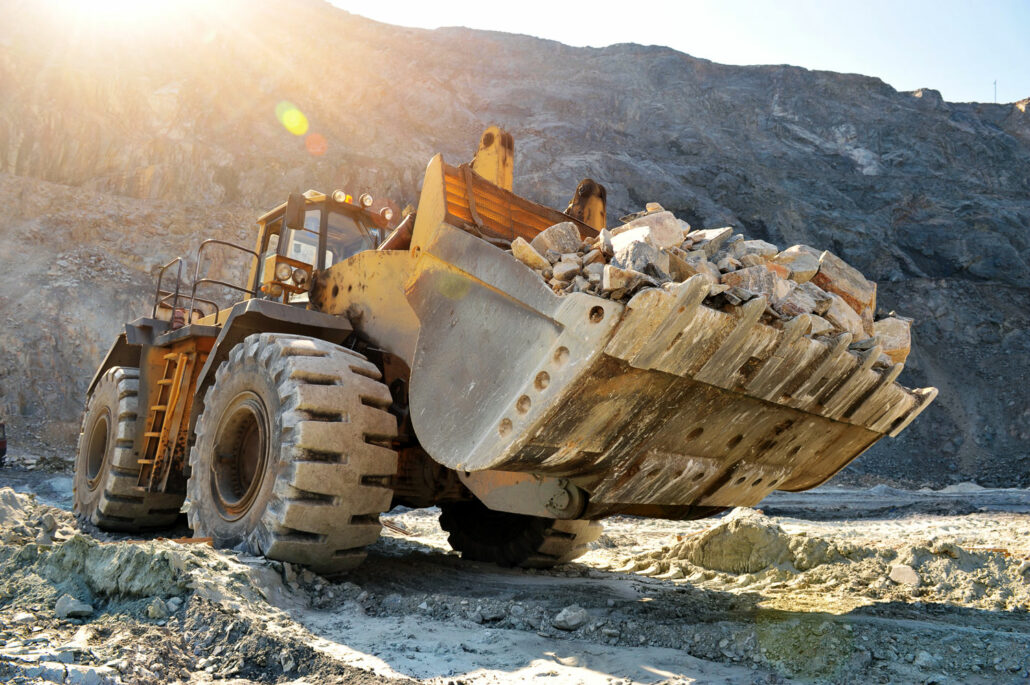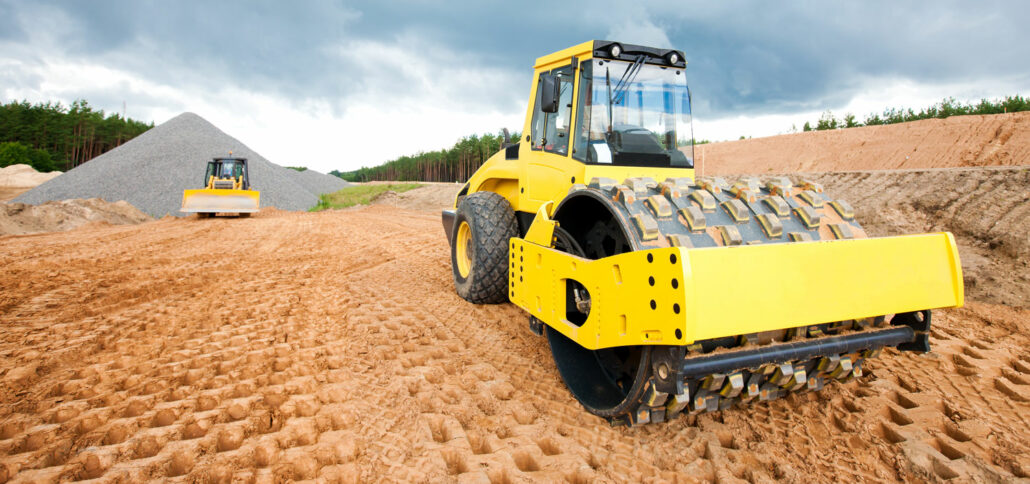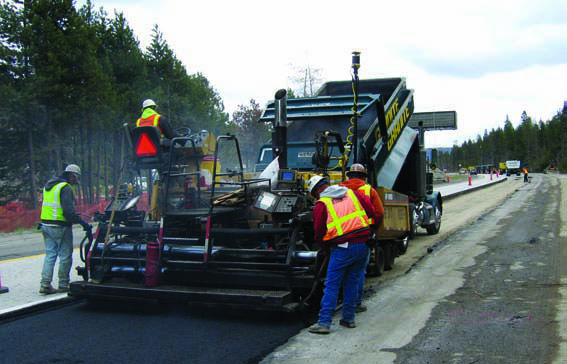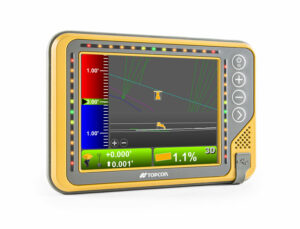Traditionally 3D machine control systems have been used on a relatively narrow band of equipment types: graders, dozers and excavators (if “tradition” can be applied to a technology that’s only been around less than two decades).
But in the past few years, we’ve seen an accelerating trend to putting these systems on a wider range of equipment, as contractors and other end-users seek to extend the productivity, efficiency, materials saving and time-reduction benefits across their entire fleet.
Equipment that is now being successfully fitted with machine control technology includes:
And as more and more equipment types are fitted with machine control, the day will surely come when an entire construction site is run by machine control-equipped plant, allowing unprecedented levels of project planning and jobsite communications.
Depending on the bucket set up, front-end loaders with machine control allow the option of a “bucket mode” and a “grading mode” (in the case of a loader with a 4:1 or multipurpose bucket). In bucket mode, there are three sensors, one each on the arm and bucket area, plus one on the body of the machine. This allows a precise location of the bucket tip when coming in to scoop a load of material, so the operator knows exactly where the bucket is and is not taking too much or too little off the ground.
It’s also possible to co-ordinate the machine control system with other technologies, so you can calculate how much is in the bucket and how much material you have moved.This setup is ideal for applications where materials are spread using a loader before grading machines – dozers or graders – come in for the final trim.

Being able to spread material using the machine control system enables you to get a very even spread across the whole work area.
And where you have material being brought to a site and dumped from tippers, the loader can come in and take just the right amount each time, then spread it to a consistent depth just where it’s needed.
This is ideal where there’s a lot of material coming in at a regular speed from trucks, and where the productivity of the wheel loader is crucial to the operation.
Another application is in moving material from one stockpile to another on a job site, and where accuracy again is crucial.
Site management might need a certain volume of material taken from one place to another, so tying this in with a weighload system where the bucket can calculate the volume makes this a very useful capability.
Bear in mind, this is still very new technology and I don’t think we have realised the full potential of it on wheel loaders yet.
Markets such as China and India, where the wheel loader is the biggest seller by tenfold over any other machine type, will really drive innovative applications of this technology.
The other application for loaders – and this applies more for crawler machines or IT loaders, which typically are fitted with 4:1 buckets – is in “grading” mode.
By adding in a sensor on the rear “blade” of the 4:1 bucket, with the front of the bucket open and lifted up, you can then have it treated as any other blade, such as on a dozer or grader, and work to your cut or fill values.
Because you don’t have the ability to angle the blade, as you do on a dozer or grader, the slope can’t be automatically controlled; it will be an indicate-only system. In the future the market may drive the need for automated height control or load detection, but we’re not there yet.
But this will still allow an operator to have clear reference where the bucket is relative to the design grade or final grade or whatever they grading to at the time.
Backhoe/loaders allow the capability to put a front-end loader system (“bucket” and/or “grading” options) on the front of the machine, and an excavator system on the backhoe end.
This has already been done, and is out in the market right now. I haven’t seen it in Australia yet, but I have seen applications in Singapore and other parts of Asia as well as in the US.
You may ask why you would put machine control technology on a machine where the system is worth almost as much as the machine itself.
But we have one customer in Australia who’s done just this – using our top-of-the-line 3D-MC2 system. They are seeing significant benefits in labour savings, having one machine able to do the work of several others, as well as faster working speeds and improved overall jobsite efficiency.
Using this technology on a skidsteer means you can bring grader-quality finish to very small, tight jobs, where the client is still demanding a high degree of accuracy.
That means you don’t have to bring in a lot of manual workers to spend a lot of time stringing and boxing out small, fiddly works such as footpaths and bicycle paths, and the like.
Certainly we have seen high-speed soil compactors fitted with machine control technology over recent years, as this gives site managers the ability to ensure that large cut and fill or other earthworks areas are properly compacted with the required number of passes.
Compactors have massive potential in the construction industry.
Looking first at self-propelled single-drum rollers – padfoot or smooth-drum – over the past few years, I’ve done a lot of work with them in China on high-speed railway jobs, where they have literally hundreds of these machines on a project.
In Australia, it hasn’t taken off quite as quickly as it has in some other countries, but it is one of those second-tier machines, like a wheel loader, where there are a lot on a job site.
So if you want to get the most out of these machines – and they do use a lot of fuel – 3D GPS can really make a difference.

It can also help, because the nature of the compaction process means that sometimes you can overdo things, which can be just as bad as under-compaction.
A lot of the drive towards machine control in compaction equipment is geared toward increasing productivity with regard to optimising compaction time, while at the same time ensuring you have uniform compaction across your work area.
GPS and machine control allows you to map the path of the compactor and enable operators to see if they have been over the work area five, 10, 15 times, whatever is required by the site standard.
That means they won’t over-compact, and at the same time don’t have to keep in their mind the number of passes they’ve done.
With regard to asphalt rollers, manufacturers are now incorporating heat temperature sensors on the drum so that asphalt temperature is being recorded as it is being compacted.
You can combine that system with a 3D GPS system, allowing you to map the temperature of the mat as it’s laid down, along with the number of passes specified, giving a very precise record of the asphalt compaction process and any “cold spots” that may have occurred.
3D GPS-equipped asphalt rollers tie in very well with machine-controlled pavers, which is our next equipment type…
Currently 3D paving is a highly under-utilised technology within Australia, especially considering how fast this technology has been adopted with motor graders, dozers and excavators.
Probably one of the reasons that paving has not adopted the technology so quickly is that the machine is a very sensitive beast.
It’s a little bit different to other equipment types in that there is a lot more going on with it, along with a lot more machine-specific controls.
Using a machine control system on a paver requires a lot of education and training – more than that required on other machine types – and the crew that runs the paver has to know their machine inside out.
But, in saying that, the results can be spectacular. 3D paving in general is a very application-specific or a job-specific application. It is more often used in high-precision jobs, such as airports and concrete-treated base laying for high-speed highways and the like, so it is generally not a technology that can work on every job every day or month of the year. However, for specific jobs, it is definitely a step up over traditional 2D methods that use contact sensors and/or sonic trackers with stringlines.

Jobs where it works well are those where you have to be spot-on with your vertical and horizontal accuracy.
In many jobs, paving contractors and their clients are more concerned about the vertical than the horizontal, but when you get into large jobs such as airports and highways, your horizontal precision, can be just as important as your vertical.
It is important to ensure you are using the same baseline, particularly when you are using machine control on say your grader or dozer doing your surface prep before the paver comes in.
You can undo a lot of good work done by your machine-controlled graders or dozers by not paving as accurately as you could be.
On the other hand, a 3D machine-controlled paver can also come in and tidy up where your base layer is not as accurate as it could be.
For example, there are systems available that allow you to place more asphalt in certain low areas on the base layer, so that when the asphalt roller does its work, it gets compacted uniformly to the correct final design specifications.
There is a lot of potential in 3D paving, and it can save significantly on fuel and materials, because you are using only what asphalt you need to.
Although the technology is very project-specific, the benefits for the right job have the potential to far outweigh the costs and associated training and preparation.
In a more specialised paving application, Topcon has recently released a 3D paving system for curb-and-guttering machines, and we will see its first use in Australia in Sydney shortly.
The customer sees the value it can add to their jobs and they are very keen to see it in action, especially when they are laying long curbs and channels, where they need high precision for both horizontal and vertical accuracy.
Profilers and milling machines have been using laser systems for years, but they are now really moving into 3D technology.
Particularly since the GFC there has been a lot of re-work – rather than new work – done in America and Europe.
Rather than building new roads, there is a lot of resurfacing happening, so 3D milling in conjunction with 3D paving has really been pushed into the market in recent years.

Bringing it all together
I think we are still some years away, but the time will come when every piece of earthmoving equipment on a project will have some form of GPS-based 3D machine control or indicate system.
Currently, there is a lot of forward planning by machine control system manufacturers to be there when that happens, although getting there will raise its own set of fresh challenges.
Once we see 3D machine control on all plant across a site, the focus will be on integrated systems, seamless communication and centralised design control.
New advances in telematics solutions such as Tokara are already seeing this come to market, with project managers, surveyors and machine operators able to communicate and send and receive design updates wirelessly and get up-to-the-second updates on all systems across the site.
Support is another challenge, which will be met with remote service capabilities that allow technicians to log onto a system remotely to diagnose, update software and change settings to reduce operator downtime.
All manufacturers are doing a great job at trying to future-proof as much as possible with current technology and adoption levels. As demand for fully integrated systems increases, it could get to the stage where we are supplying full network infrastructure for a site throughout, say, the five years of the project.
But that is a matter for a future article.

We source, deploy and support intelligent positioning solutions to enhance our customers’ productivity.
Aptella Pty Ltd
ABN 56 130 367 065
2024 Aptella Pty Ltd | ABN 56 130 367 065 | Terms and Conditions | Privacy Policy